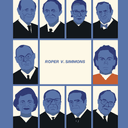
North Carolina’s death penalty is a weapon of social control rooted in a racist past. That is the message of a groundbreaking new collaborative project, Racist Roots: Origins of North Carolina’s Death Penalty, by the Durham-based defense organization Center for Death Penalty Litigation (CDPL).
Through essays and academic articles containing in-depth analysis, photographs, archival news-clippings, poetry, and stirring personal narratives, the CDPL staff and a legion of notable contributors examine 400 years of the state’s use of capital punishment to build an argument that North Carolina’s “death penalty’s history is inseparable from our history of slavery, Jim Crow, and mass incarceration.”
Veteran capital defense and civil rights lawyer Henderson Hill, the founder and first director of CDPL, writes in the introduction that “[t]his report lays bare what too many people, lulled by the myth of a post-racial society, have allowed themselves to forget.… When we open our eyes to the history of capital punishment, the conclusion becomes inescapable. The death penalty is just one more Confederate monument that we must tear down.”
Reviewing the current landscape of capital punishment in North Carolina, the CDPL staff says, “the death penalty continues to achieve exactly what it was intended to do when it began: Punish the powerless and cement the supremacy of the powerful. It remains the ultimate symbol of state control.” In support of this argument, they marshal an array of facts:
- People of color make up less than thirty percent of North Carolina’s population but sixty percent of its death row.
- Black defendants are far more likely to be wrongly convicted. Nine of the state’s ten death-row exonerees have been Black or Latinx.
- Nearly half of death row were tried by an all-white jury or a jury with just one person of color.
- Prosecutors across North Carolina, with consistency across both time and geography, strike Black jurors from capital juries at two and a half times the rate they strike white jurors.
- Defendants accused of killing white victims are twice as likely to be sentenced to death.
- Three-quarters of those executed had been convicted of killing a white person.
The death penalty, the staff continues, “makes Black men the face of violence, while obscuring the fact that throughout American history, white people carried out a sustained campaign of racial terror. … In all these years of state-sponsored killing, North Carolina’s leaders have rarely paused to consider whether a state that enslaved human beings, lynched people, let the Ku Klux Klan run rampant, and sent children to the execution chamber ought to have a death penalty at all.”
The Racist Roots Project
The project intermixes research and academic essays with interviews, op-eds, and poetry, exposing the lingering traces of slavery that have tainted each historical era of capital punishment and “expos[ing] its deep entanglement with the aims of white supremacy.” It is divided into four chapters: Slavery, Lynching, and the Era of Public Hangings (1619 – 1910); Jim Crow & the Birth of the State-Run Death Penalty (1910 – 1961); Backlash to Civil Rights & the Creation of the Modern Death Penalty (1961 – 1990); and The Death Penalty in the Age of Mass Incarceration (1990-Present). The CDPL staff and contributors like civil rights icon, the Rev. Dr. William Barber; NAACP Legal Defense and Educational Fund President Sherrilyn Ifill; poet and activist Clint Smith; and Emancipate NC Executive Director Dawn Blagrove make starkly clear the persistent racism in North Carolina’s death penalty.
“The death penalty and lynching lived together in braided fashion in North Carolina from the outset, to maintain slavery and subdue those who dared rebel,” writes contributor Tim Tyson, a writer and historian from North Carolina. The project explains how, as a way to preserve slavery, North Carolina executed more than a hundred enslaved people in the 1700s and, while many northern states began to abolish the death penalty in the antebellum period, the South maintained its harsh penal codes. When, after the war, the federal government began to withdraw its military presence and formally end the Reconstruction Era, white supremacists launched a campaign of mob violence and lynchings to preserve the racial hierarchy and retake power. The project includes newspaper clippings that describe attempted lynchings of Black men that led swiftly to legally-sanctioned executions, demonstrating how brutal mob violence and state-administered executions were really “two sides of the same coin.”
When public hangings became too barbaric for the 20th century, the project explains, North Carolina turned executions into a more “centralized and sanitized” affair. Between 1910 and 1961, 362 people were put to death by the state in the electric chair of Central Prison, 80 percent of whom were Black. In the section Jim Crow & the Birth of the State-Run Death Penalty, the report asserts that “[t]he state’s attempts at modernization changed only the appearance of the death penalty. They did nothing to alter the racialized fear and anger that lay at the heart of capital punishment.”
The Civil Rights Movement of the 1960s greatly altered the country’s discussion of race but opponents quickly painted protesters as anarchists and called for “law and order.” The project notes that this “tough on crime” rhetoric has persisted as those opposed to systemic reform continue to demonize those protesting mass incarceration and systemic inequality in the United States. As the country reckoned with these issues in the wake of the murders of George Floyd, Ahmaud Arbery, and Breonna Taylor in the summer of 2020, “historians were not shocked when the President of the United States accused protestors of ‘Treason, Sedition, Insurrection!’ or by the braying about ‘Law and Order,’” the report says.
The project also highlights specific North Carolina death-penalty cases that demonstrate the persistent injustices and legacy of racism in the state’s death-penalty system. In ‘A Worthless, Good-for-Nothing Mammal’: Painting Black Defendants as Animals, the CDPL describes how “the use of animal imagery to describe Black criminal defendants plays into a long and brutal history of dehumanizing Black people.” The project describes the trials of Guy LeGrande, Kenneth Rouse, Tilmon Golphin, and Ryan Garcell, all of which were tainted by racism, including prosecutors who struck every potential Black juror, empaneled jurors who harbored hateful feelings towards minorities and the mentally ill, and witnesses who used racial slurs on the stand. In Rouse’s case, one of the jury members said that “bigotry” was a primary factor in his decision to vote for death.
Expanding beyond North Carolina, the project also focuses on the U.S. Supreme Court’s 1987 decision McCleskey v. Kemp, in which, faced with a compelling statistical study demonstrating racial discrimination in the death penalty’s application, the Justices didn’t deny the evidence but refused to act on it. John Charles Boger, a law professor who represented petitioner Warren McCleskey, described McCleskey as an act of “grand racial avoidance.”
The project also includes op-eds penned by death-penalty abolitionists. Former prosecutors Liz Komar and Miriam Krinsky write that “[t]he death penalty furthers none of its stated aims and our irrational dedication to it in America reveals the disheartening truth at the heart of capital punishment: We kill because we hate, not because we seek justice.” And in his op-ed, Racism and the Death Penalty: The Intertwined Ropes of the Lynchman’s Noose, the Rev. Dr. William J. Barber asserts that the “link between slavery, Jim Crow, lynching and the death penalty is as connected as the intertwined ropes of the lynchman’s noose.”
In his essay, Death Qualified, current North Carolina death-row prisoner Paul Brown recounts his experience in the courtroom the day he was sentenced to death for murder: “The jury voted for death. Mom wailed bitterly. My 14-year-old daughter screamed. ‘Lord Jesus… JESUS!’ Aunt Rose cried. The victims’ family members embraced sobbing. The judge crashed down his gavel like a sledge hammer and told them they were all out of order. There was no place for human emotion in the arena. I was enchained. ‘Be strong, Daddy!’ My angel was now an orphan.”
In concluding North Carolina’s Modern Death Penalty is the Fruit of a Racist Past, the CDPL authors clearly state the project’s thesis and call to action: “Just like a Confederate monument, the death penalty has always been a symbol of white supremacy. Now, there is only one thing left to do with this poisoned tree. Dig it up and salt the earth. Never again assert the state’s power to kill any human being.”
Center for Death Penalty Litigation, Racist Roots: Origins of North Carolina’s Death Penalty, October 5, 2020; Herbert L. White, NC death penalty foes push equity task force for repeal, The Charlotte Post, October 6, 2020; Rob Schofield, Series exposes the dreadful history of North Carolina’s death penalty, NC Policy Watch, October 7, 2020.


